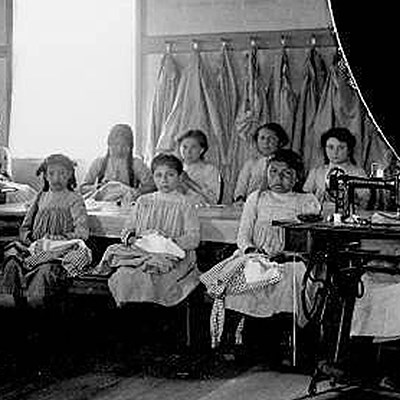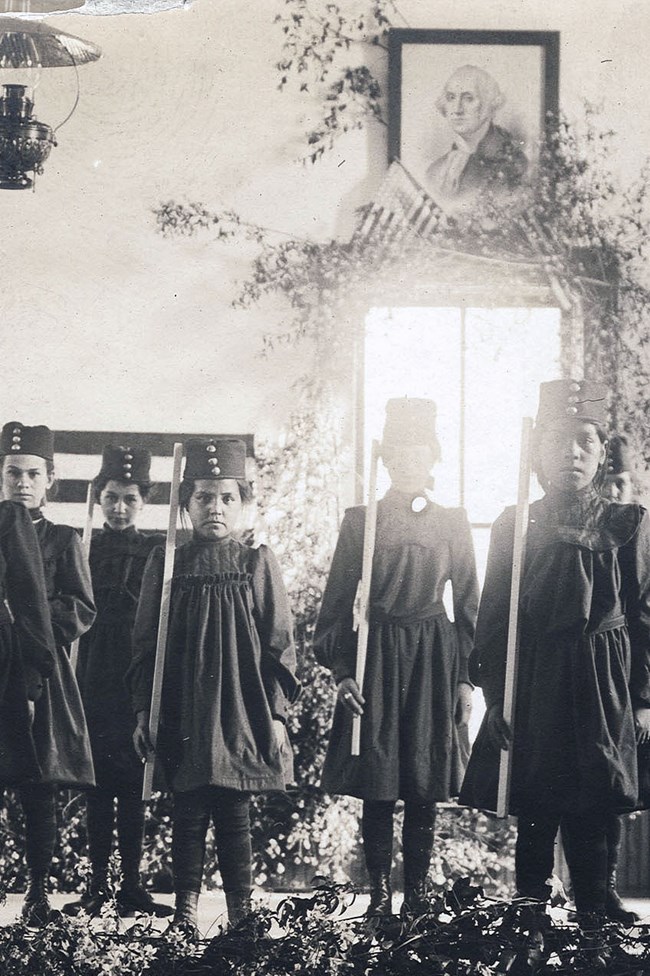Part of a series of articles titled Home and Homelands Exhibition: Loss.
Article
Fort Spokane Indian Boarding School

NPS Collections, LARO 2246
Article written by Nicole Martin, PhD
In the photograph above, uniformly dressed girls of various ages stand at tables ironing. They are focused, working in a large laundry room with bare walls. This scene captures an ordinary afternoon at the Fort Spokane Indian boarding school. The Indigenous girls pictured had all been forcibly separated from their families and homes.
“I have never forgotten how the steam in the laundry made me sick; how standing and ironing for hours made my legs ache far into the night,” recalled Irene Stewart, a Navajo girl who attended a boarding school in Arizona. “I think this is why the boys and girls ran away from school; why some became ill; why it was so hard to learn. We were too tired to study.”1
Fort Spokane Indian Boarding School
Founded originally as a military fort in 1880, Washington State's Fort Spokane served to contain the Confederated Tribes of the Colville and the Spokane Tribe of Indians on their reservations and buffer them from emigrating white settlers.2 Converted into a boarding school from 1900-1907, it became a critical site for the separation of Indigenous children from their families, communities, and homelands. Of the 408 federal Indian boarding schools established in the United States between 1819-1969, Fort Spokane is the only former boarding school owned and managed by the National Park Service. The surviving buildings are preserved as part of Lake Roosevelt National Recreation Area.3
Before boarding school attendance became mandatory, the children on the Colville and Spokane Reservations grew up surrounded by relatives. Home meant a complex network of family ties, responsibilities, and obligations that connected children to distant relatives, kin, and to the land itself. With the establishment of the boarding school at Fort Spokane, the Colville Indian Agency closed local reservation day schools and threatened to imprison parents if they did not send their children. For some families, this meant sending children as young as five years old as far as sixty miles away.4
At the boarding school, officials and reformers sought to Americanize their students by erasing the children’s Native identity, including severing their connection to their ancestral lands and replacing it with an entirely new way of life. The photo of girls working in the laundry room captures how the Fort Spokane Indian boarding school attempted to reshape Indigenous children through coerced assimilation and labor.

NPS Collections, LARO 3016
Learning to Make a Fixed Home
The girls ironing in the photo wear long western-style dresses. When children first arrived at the school, teachers forced the children to take a bath and disposed of their soft buckskin clothing. They then dressed them in wool and cotton tailored clothes and cut the long braids that boys had grown since birth. These bodily “transformations” were immediate assaults on important aspects of the children’s cultural identity and sense of home.
Irene Stewart remembered the shock of being snatched away from all her loved ones and her “home place.” She wrote decades later, “I was homeless. No one cared for me as my old home folks had. I feared everything, especially the people and the strange facilities.”5
The people Stewart mentioned included matrons like the one standing in the back of the photo who oversaw the girls’ work. The government hired white women in the roles of “mothers” to replace the children’s actual mothers. These women performed the day-to-day work of socializing the Indigenous children in the ways of dominant American society through surveillance and discipline.6
The photo’s setting of the laundry room – formally the fort’s guardhouse – also speaks to the institutional control central to boarding school life. Strict rules governed every moment of the day. Indian boarding schools were run with military discipline, including drills, inspections, marching, and rigid timetables for work and school. This stood in stark contrast to most Indigenous conceptions of time and education that emphasized following the natural cycles of the sun and seasons and blended hands-on practice and play.7

Washington State University Libraries Digital Collections
Each afternoon, girls and boys went to separate vocational classes in order to learn American traditions of gendered labor. For the girls, this meant an inordinate amount of time indoors learning the domestic arts of an American home – such as laundry – while boys learned farming and industry. In both cases, authorities sought to break the children’s association with the natural world and their ancestral lands.8 Back home, girls on the Colville and Spokane reservations would have learned to dig camas roots with special digging sticks, how to tan hides, make baskets, and prepare food while boys learned to hunt and fish and fashion weapons and tools.
Reformers and school authorities claimed they taught Indigenous children the art of making a “fixed home” in hopes that the students would return to the reservation and spread this version of “civilization” among those living traditionally.9 However, the heavy focus on vocational training served to prepare children to work in the capitalist economy as exploited, low wage laborers. Indian boarding school “outing programs” placed students in white homes as domestic servants under the pretense of providing a civilizing influence and creating self-reliant citizens. In reality, these programs saved the state money while also supplying cheap labor to white homes.10
What’s Not Depicted

NPS Collections, LARO 2228
While the photo above captures many dimensions of the boarding school experience, it leaves just as much out. If we were to listen in as the girls iron, we would hear them only speaking English, as they were forbidden to speak their native Salish. They would refer to each other using the new Americanized names they had been forced to assume upon arrival. If we could follow the girls out the door, we would learn that they slept in large, cold dormitories where they were not allowed the comfort of keepsakes from home. We would find an educational environment where locking children in cramped solitary confinement cells formally used to punish soldiers was acceptable and illness took many young lives.11
With no mothers, fathers, or relatives to comfort them, the girls in this photo likely often felt lonely and homesick. At almost every turn, the boarding school experience involved the total dispossession of their sense of home. Authorities removed them from their homes and ancestral lands in order to teach them to embody an entirely new version of home. As tribal members today explain, the government policy of the boarding school era “tore the very fabric of tribal society.”12
Most importantly, the photo cannot show us how the children coped and resisted. Many ran away despite facing severe punishment if caught. Others secretly practiced traditions, telling Native stories late at night or through play at recess.13 Over time, Colville and Spokane parents refused to send their children, eventually forcing Fort Spokane to shut its doors. Today, the Colville and Spokane Tribes are helping the U.S. reckon with this devastating history by speaking out and revitalizing their connection to their homelands.“It is our Language and Culture,” Tribal members explain, “that offers a healing process to overcome the damage of Boarding Schools for this generation and those to come.”14
1 Irene Stewart, A Voice in Her Tribe: A Navajo Woman’s Own Story (Ballena Press, 1980), 17.
2 “Fort Spokane Military Reserve,” National Register of Historic Places Registration Form (Washington, D.C.: United States Department of the Interior, National Park Service, 1988), Section 8.
3 U.S. Department of the Interior, “Department of the Interior Releases Investigative Report, Outlines Next Steps in Federal Indian Boarding School Initiative,” press release, May 11, 2022.
4 Unless otherwise noted, information in this article comes from Lake Roosevelt National Recreation Area with the assistance of Colvilles, Spokanes, and nimíipuu tribal members, March 20, 2023.
5 Stewart, A Voice in Her Tribe, 15.
6 Margaret Jacobs, White Mother to a Dark Race: Settler Colonialism, Maternalism, and the Removal of Indigenous Children in the American West and Australia, 1880-1940 (Lincoln: University of Nebraska Press, 2009), 281-82.
7 Jacobs, White Mother to a Dark Race, 238, 240, 243. See also U.S. Department of the Interior, “Department of the Interior Releases Investigative Report.”
8 Jacobs, White Mother to a Dark Race, 242, 245.
9 Estelle Reel, the national superintendent of Indian schools from 1898-1910, wrote, “For almost the first time in the history of government dealings with the Indian there is now a serious attempt made to foster in the wild red soul the instinct for a fixed home, a home that the male Indian must maintain by his own labor, while the female Indian keeps the house and makes the home.When you can make a young Indian feel that he must support his family or do without one, you’ve got him for civilization.” Quotation in Jacobs, White Mother to a Dark Race, 303.
10 For an in-depth look at the “outing programs,” see Jacobs, White Mother to Dark Race, 329-69.
11 Colin Tiernan, “‘All These Children Matter’: Discovery of Indian Boarding School Graves Shines Spotlight on Cultural Genocide, with Ripple Effects Felt in Spokane,” The Spokesman Review, July 8, 2021.
12 Quotation from Colvilles, Spokanes, and nimíipuu (Chief Joseph Band), who assisted with Lake Roosevelt National Recreation’s Fort Spokane Boarding School Display, 2008.
13 For more on student resistance, see David Wallace Adams, Education for Extinction: American Indians and the Boarding School Experience, 1875-1928, 2nd ed., rev., (Lawrence: University Press of Kansas, 2020), 250-265. For how Spokane Indians retained their Native language despite government and mission schooling, see John Ross, The Spokane Indians (Spokane, Wash.: Michael J. Ross, 2011).
14 Quotation from Colvilles, Spokanes, and nimíipuu (Chief Joseph Band), 2008.
Last updated: June 11, 2024
